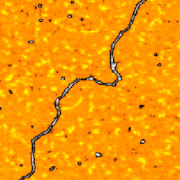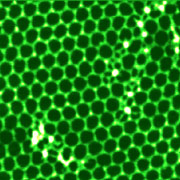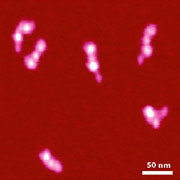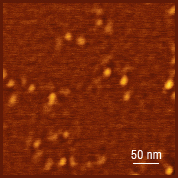Nucleic acids, DNA, RNA and various proteins are the most common biomacromolecules examined with AFM. Visualization of conformations of individual DNA strands, DNA-protein complexes and other single macromolecules brings unique information that is hardly accessible by other methods.
An example of an AFM image of DNA is given in Fig 1a. Supercoiling is one of the most interesting DNA-related phenomenon, which is the focus of many studies with emphasis on high-resolution imaging with ultra sharp AFM probes. High-resolution visualization of DNA is also the subject of studies addressing the formation of DNA-protein complexes and the results of enzyme cleavage. Other properties that have been successfully investigated with AFM are DNA stiffness and elasticity and the segmental dynamics of DNA. In the past five years, there has been intense research into the construction of 2D and 3D architectures using self-assembly of single stranded DNA macromolecules. AFM has become the most useful technique for the characterization of these arrays. One such example is the hexagonal DNA array is seen in Fig. 1b.
Fig. 1. AFM images of double stranded DNA on mica (a) and hexagonal DNA self-assembly. Image courtesy of S.Magonov (Agilent). Sample courtesy of A. Koyfman (UCSB). |
 |
 |
| (a) AFM image (400nmX400nm) of double stranded DNA on mica obtained with a Hi'Res-C14/Cr-Au AFM probe. |
(b) AFM image (400nmX400nm) of hexagonal DNA self-assembly obtained with HQ:NSC14 AFM probe. |
An example of AFM images of another biomacromolecule is given below.
Two AFM images of plasma protein fibrinogen and its assemblies known as fibrin are presented in Figures 2a-b. These images demonstrate that Hi'Res-C probes provide higher resolution in images of the fibrin, making fine features of the aggregate visible.
Fig. 2. AFM images of fibrinogen molecules (a) and single fibrin strands (b). The image in (a) has been obtained with a standard HQ:NSC14 AFM probe and the image in (b) - with a Hi'Res-C AFM probe. The color contrast (red-to-white) covers 0-3.5nm height scale. Images are courtesy of L. Chtcheglova. |
 |
 |
| (a) Fibrinogen molecules. Scan size 300nm. |
(b) Single fibrin strand. Scan size 400nm. |
Topography image of individual fibrin molecules obtained using a General Purpose probe is shown in Fig. 3.
| Fig. 3. Tapping mode topography image of single molecules of fibrinogen on mica (Agilent 5500 AFM, standard R<10nm AFM probe). Scan size 350x350nm. Scan height 1.5nm. Image courtesy of S. Magonov, Agilent Technologies. |
 |




